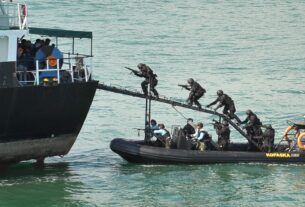Piracy in Asia-Pacific region is growing and the pirates are graduating from mere bandit like organization to a full-fledged regular militia which is seizing commercial ships and demanding ransoms more frequently than ever before.
There were not any incidents involving the abduction of crew from ships in the Sulu-Celebes Sea and waters off Eastern Sabah in October and there were no incidents involving the hijacking of ship for theft of oil cargo.
However, there was an increase in the number of incidents occurring on board ships while underway in the Straits of Malacca and Singapore (SOMS).
The number of incidents occurring during January-October this year was 60, the lowest for the same period over the last 10 years. But suddenly it is increasing now due to a wide ranging factor.
ReCAAP ISC attributes the improvement to, among other factors, improvement of the situation at certain ports and anchorages in Malaysia, India, Indonesia and Vietnam but experts believe now new outfits are entering into the game which may complicate the situation.
Over the time, there was an increase in the number of incidents reported at ports and anchorages in Bangladesh (Chittagong), Philippines (Manila and Batangas) and on board ships while underway in the SOMS where all seven incidents occurred in the Traffic Separation Scheme (TSS) of the Singapore Strait.
Mostly opportunistic in nature, the perpetrators boarded the ships unnoticed during hours of darkness; and escaped immediately when they were sighted and the alarm was raised. In four incidents, the perpetrators escaped without stealing anything when the alarm was raised.
According to the report from the ICC and IMB, pirates in Southeast Asia hijack a small coastal tanker every two weeks on average. Recent reports show that from January until June this year, 56 cases of piracy had taken place in the Malacca Strait.
Of this number, 21 were cases of suspected piracy, 22 were attempted piracies, and 13 were confirmed piracies. Indonesia has the highest number of attacks, accounting for almost 40 percent of the attacks in 2015.
Vietnam has also seen an increase in armed robbery incidents, with thieves breaking into ships at anchor. Most acts of piracy are carried out by armed gangs that target small coastal tankers to steal their fuel.
The increased frequency of piracy attacks in Southeast Asia can be compared with incidents in Somalia. According to an April 2015 IMB report, there were zero incidents of piracy for Somalia in the first quarter of 2015. If these figures are accurate, Southeast Asia has now regained the reputation as the worst region in the world for piracy.
Indonesian Navy Western Fleet commander recently gave assurances that the Malacca Strait was safe, unlike Somalia’s waters, because ASEAN countries were able to provide security to its users.
But is this claim credible? To date, the states of Southeast Asia have struggled to tackle the threat posed by piracy. The Malacca Straits Coordinated Patrol, codenamed MALSINDO, is a regional effort to suppress piracy.
Introduced in 2004 by Malaysia, Singapore and Indonesia, MALSINDO conducts coordinated patrols within each state’s territorial sea.
However, out of respect for state sovereignty, the patrols are not allowed to engage in cross-border pursuit into the territorial waters of another state. MALSINDO has therefore struggled to significantly reduce instances of piracy.
An aerial patrol known as “Eyes in the Sky” (EiS) has attempted to address this issue, allowing aerial patrols to travel up to three nautical miles over another state’s territorial sea.
However, EiS has been criticized for the low number of flights actually taking place, and the limited resources available to respond to incidents spotted during aerial patrols.
According to a senior officer from Vietnam’s Department of Foreign Relations under the Ministry of Public Security, ASEAN countries should step up efforts to share intelligence and hold law-enforcement exercises.
Because maritime security issues only affect certain ASEAN member states, the organization has yet to provide an effective response to the increased threat of piracy. To date, there is no anti-piracy measure involving all ASEAN member states.
Forums such as the ASEAN Maritime Forum (AMF) and Maritime Security Expert Working Group (MSEWG) aim to address problems associated with maritime security. While these enhance dialogue between member states, they have not resulted in actual measures to tackle piracy that involve all ASEAN member states.
These issues are symptomatic of a wider problem relating to ASEAN’s ability to respond to transnational threats. The recent Rohingya migrant crisis and the discovery of mass graves in Malaysia and Thailand have highlighted ASEAN’s poor record on human trafficking.
Similarly, ASEAN has made little headway in fighting the haze, despite numerous meetings and action plans designating the environmental issue a high priority. ASEAN struggles to provide a coordinated response to regional crises. ASEAN forums also have difficulty moving policies from the dialogue stage to the implementation stage.
According to Indonesian Navy, an ASEAN pact has proposed the establishment of an ASEAN Navy to combat piracy in the Malacca Strait. However, true to form, this proposal is still currently under discussion.
If ASEAN is going to shed its image as a “talking shop,” it is going to have to move quickly to respond to regional transnational threats. If it fails to do so, it risks losing what little credibility it still has, both regionally and among the wider international community.
Malacca Strait is emerging as battle ground for the pirates. Imagine an aquatic highway flowing between two marshy coasts. One shoreline belongs to Malaysia, the other to Indonesia. Each offers a maze of jungly hideaways: inlets and coves that favor pirates’ stealth vessels over slow, hulking ships.
It is a narrow route running 550 miles, roughly the distance between Miami and Jamaica. This bottleneck is plied by one-third of the world’s shipping trade. That is 50,000 ships per year — ferrying everything from iPads to Reeboks to half the planet’s oil exports.
The world’s fascination with neo-piracy now centers on Somalia. Thanks to the 2013 thriller “Captain Phillips,” in which Tom Hanks plays a cargo ship captain abducted by Somalis, even US teenagers know the anarchy-prone African state is a breeding ground for pirates.
At least it was. In truth, Hollywood stumbled onto Somalia’s piracy phenomenon rather late. In the last three years, pirate strikes in Somali waters have plummeted 95 percent to a meager seven incidents in 2013; none were successful.
Piracy in Southeast Asia, meanwhile, is accelerating. Attacks and attempted attacks in the waters of Indonesia — which controls much of the Malacca Strait and its environs — totaled 107 last year. That’s a 700 percent increase in just five years.
The German insurance firm Allianz, which released these figures in a new report, is now sounding a warning: Southeast Asian piracy must be reined in before it is too late.
The attacks mostly amount to “opportunistic thefts carried out by small bands,”according to Allianz, but these syndicates could potentially “escalate into a more organized piracy model.”
None of this would surprise 18th-century European spice traders. They lived in terror of Malacca Strait pirates who staged bloody ship raids — all from the same shores cargo ships chug past today.
Piracy has long transfixed locals “born to the hard and dreary life of the fisherman,” writes historian Donald B Freeman in the 2003 book “Straits of Malacca: Gateway or Gauntlet?”
A pirate’s life, Freeman wrote, was traditionally viewed in the region as a “passport to adventure, riches and prestige rather than a criminal occupation.” This tradition, paired with the pirate-friendly terrain, “helped give the region a reputation that made merchants and legitimate seafarers tremble at the very thought of traversing the strait.”
Modern-day captains plying risky waters look to a guide called the BMP. Based on intel from Western navies and shipping firms, it offers tactics on avoiding pirates and — if that doesn’t work — fending them off and surviving abduction.
“These pirates just want the cash aboard the vessel or to rob the crew of any valuables”. No pirates have ever boarded a ship pushing 18 knots, or nearly 21 miles per hour, the guide says. But that is practically impossible in the Strait of Malacca.
The channel is simply too crowded and too shallow. Gigantic vessels are instead forced to churn through at slow speeds that invite pirates in fast-moving skiffs.
Indonesian pirates typically have different tactics from their Somali counterparts, who’ve made headlines by invading vessels and demanding multimillion-dollar ransoms.
In the Malacca Strait, pirates like to get in and get out. Their “modus operandi isn’t to kidnap,” according to Tim Donney, an Allianz marine risk consultant. “These pirates just want the cash aboard the vessel or to rob the crew of any valuables.”
In 2005, piracy in the Malacca Strait grew so rampant that Lloyd’s of London, a prestigious insurer, declared it a “war zone.” Regional militaries of Singapore, Malaysia and Indonesia responded by upping warship patrols in the strait.
But pirates have simply shifted into distant island chains beyond the strait’s exit along the route to China.
Indonesia is not nearly as lawless as Somalia. But both are coastal nations where poverty is rife and police are ill-equipped. Both also happen to be situated on routes trafficked by wealthy nations’ trade vessels.
“Most piracy takes place in areas where people are poor. Their livelihood has been taken from them by globalization, civil unrest or war,” writes Nigel Cawthorne, author of the book “Pirates of the 21st Century.”
Somali pirates also forced the shipping industry to get creative. They’ve come up with effective pirate-proofing techniques that could be applied to more ships entering the Malacca Strait.
The BMP recommends blasting approaching pirates with hot water, ringing ships with razor wire and even installing electric fencing. Discharging foam, according to the manual, is “effective as it is disorientating and very slippery.”
Piracy along the Malacca Strait route should be easier to fight than in Somalia. All of the nations patrolling the strait have functioning governments, committed to fighting the problem, and are financially incentivized to maintain a bandit-free trade route.
Piracy’s historical influence here is legendary. In the 1820s, the Dutch and British empires drew a line in the sea and agreed to hunt down pirates on their respective sides; that line went on to become the modern-day border between Malaysia and Indonesia.
The word “boogeyman” is also inspired by fearsome pirates from an ethnic group in Indonesia known as the Bugis.




